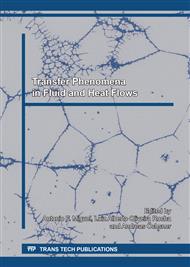p.68
p.78
p.90
p.98
p.103
p.113
p.120
p.130
p.141
Twice Optimized Evaporative Cooling System with Vortex Tube
Abstract:
A new configuration of a hybrid system for cooling electronics using a Vortex Tube is presented. The optimization of the geometry and functional parameters is based on the assumption that the thermal interaction between the moist air stream and the heat-generating electronic board, and the phase change of liquid water vaporization occurs simultaneously. The first step of this analysis is focused on the optimal geometry of the system, while the second step identifies the Vortex Tube regime that maximizes its coefficient of performance. The cooling below the adiabatic air saturation temperature and the increase of moisture transport explain the high performance of the new device. Our results shed some light on the practical procedure for the optimal configuration of the new system.
Info:
Periodical:
Pages:
103-112
Citation:
Online since:
January 2017
Authors:
Keywords:
Price:
Сopyright:
© 2016 Trans Tech Publications Ltd. All Rights Reserved
Share:
Citation:


